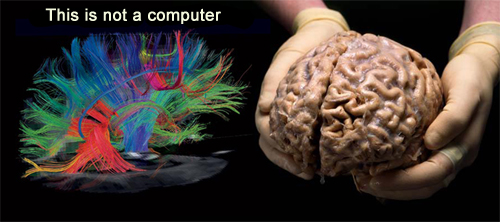Tuesday, 26 September 2017
The Brain: The History of an Organ Like No Other
 In the spring of 2017, I had to give a one-hour basic lecture about the human brain as part of a a free course for the general public at UPop Montréal. With so many different possibilities, deciding what approach to take in my lecture was no small challenge. In the end, I decided to start by trying to explain what the brain is not and dispelling a number of frequent misconceptions.
In the spring of 2017, I had to give a one-hour basic lecture about the human brain as part of a a free course for the general public at UPop Montréal. With so many different possibilities, deciding what approach to take in my lecture was no small challenge. In the end, I decided to start by trying to explain what the brain is not and dispelling a number of frequent misconceptions.
Most of the metaphors that compare the brain with a computer are pretty misleading, so I began by taking them apart, and then replacing them with others that better account for the selective, self-organizing dynamic processes that take place in the human brain and make the subtlest mental states possible. Thus, instead of comparing the brain to a computer, I used metaphors such as strange attractors in chaos physics and the complex flow patterns in a mountain stream—metaphors that can embrace both the long evolutionary history of the human brain, which accounts for its overall structure, and the neural networks that develop in an individual’s brain through a process of selection over that person’s lifetime.
But most of all, I wanted to convey how all this complexity has developed, from the very start of life as we know it. Because trying to understand today’s human brain, with its strange form and densely interconnected networks, is a bit like trying to understand how to fly a 747 by walking onto its flight deck for the first time. You just can’t do it: every element of the control panels is so complex and has such complex interactions with the rest of this jetliner. You’d have a much better chance with a small Cessna, or even better, with the Wright brothers’ first airplane!
So that’s how I approached my presentation: by showing how closely cognition seems to be linked with the simplest manifestations of life. Then I told how this fundamentally embodied conception of cognition lets us assign positive or negative meanings to certain elements of our environment.
Embodied cognition means that every living organism is a small island of order in a sea of disorder, a local exception to the second law of thermodynamics, according to which the total entropy (disorder or disorganization) in the universe is ever-increasing. Every living organism resists this tendency toward disorganization by constantly seeking substances that it can metabolize to renew its own components (which are constantly degrading, according to this same law) and by fleeing the dangers that directly threaten the integrity of its bodily structure.
Animals’ behaviours such as approaching resources and avoiding pain have thus emerged from the sensorimotor loop of their nervous systems. In complex nervous systems such as those of humans, this loop is increasingly modulated by a myriad of “interneurons”—neurons that are neither sensory nor motor and are found in the vast reaches of the associative cortex. These neurons can be activated not only “online” (when the brain is interacting with the outside world in real time) but also “offline” (when it is engaged in all kinds of abstract thoughts and simulations internally).
So that, in very broad outline, is the approach that I took in my presentation. It’s a far cry from the functionalist, disembodied approaches that are still far too common in most textbooks. If you want to see how this thesis of the continuity between life and cognition(or, if you prefer, between life and mind) is more hotly debated than ever in contemporary cognitive science, I suggest you read an article that appeared recently in the journal entropy, entitled “Where There is Life There is Mind: In Support of a Strong Life-Mind Continuity Thesis“.
This very broad view of human cognition as part of a continuum dating back to the origins of life is all the more stimulating in that scientists are beginning to show (as in the article just cited) that it is compatible with even broader physical principles of minimization of free energy (roughly speaking, good old entropy) and thus connects human thought with nothing less than the rest of the universe.
From the Simple to the Complex | No comments







